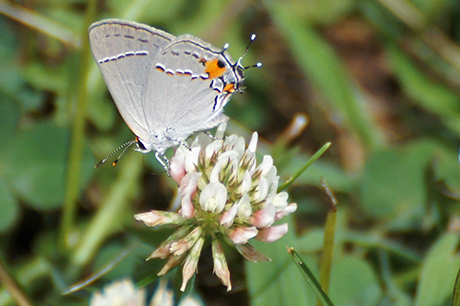
MIKE MILLER
This year, mowing of the property was cut back to maintaining just a few areas around buildings and parking lots. Staff also maintained a mowed pathway to give visitors a loop trail from the parking lot. Just what progress has nature made since the maintenance schedule was modified? A walk along the trail will show you that nature is not an idle thing.
The trail from the parking area heads east towards the Illinois River. Along that path, I heard the melodic song of the Eastern Meadowlark and the scolding chatter of an Eastern Kingbird. These two species of grassland nesting songbirds are quite appreciative of the new habitat that was created when the mowing stopped. Closer to the river, an adult Bald Eagle was being pestered by a fledgling eagle in the top of a tall cottonwood tree. I frequently see Bald Eagles perched in the tall trees between the footprint of the old course and the river. The increased solitude after the golf course closed is definitely appreciated by this pair. However, I get the feeling that this parent eagle is hoping that the young one will soon become much more independent.
Earlier this year, flooding covered portions of the old golf course. Wherever it did, you can see the high-water mark on the former golf course. Logs from trees sit atop shallow mounds that once were tees. A Pileated Woodpecker is dutifully tearing one of these logs into woodchips in an attempt to extract a nest of carpenter ants. The high-water mark also is evident from what is missing in the area that was flooded. The turfgrass that is ubiquitous in areas that didn’t flood is absent in those areas that did flood. It has been replaced by floodplain loving plants such as Moneywort, Fogfruit and Illinois Mimosa. One species that is in full bloom on my hike today is the Halberd-leaved Rose Mallow. This is a native hibiscus with huge pinkish-white flowers that are 4 inches across.

Gray Hairstreak butterfly is feeding on a white clover flower at Detweiller Riverside Park, formerly the 9-hole Detweiller Golf Course. (PHOTO BY MIKE INGRAM)
Throughout the newly emerging flowering plants, where once there was only turf grass, dance a myriad of butterflies. Mike Ingram, the naturalist at Peoria Park District’s Tawny Oaks Field Station, did a quick survey and identified over 10 species of butterflies in one pass. One of these is the diminutive Gray Hairstreak, and it has a connection with the Halberd-leaved Rose Mallow. The mallow’s flower buds and developing seeds are one of the favorite foods for the caterpillars of the Gray Hairstreak.
So, Nature has not been idle at a former golf course. If anything, it has renewed its memory of what a floodplain should function like… how the pulse of rising and retreating waters bring together a unique assemblage of species that call this place home. Make sure you take some time and explore “Detweiller Riverside” today!
